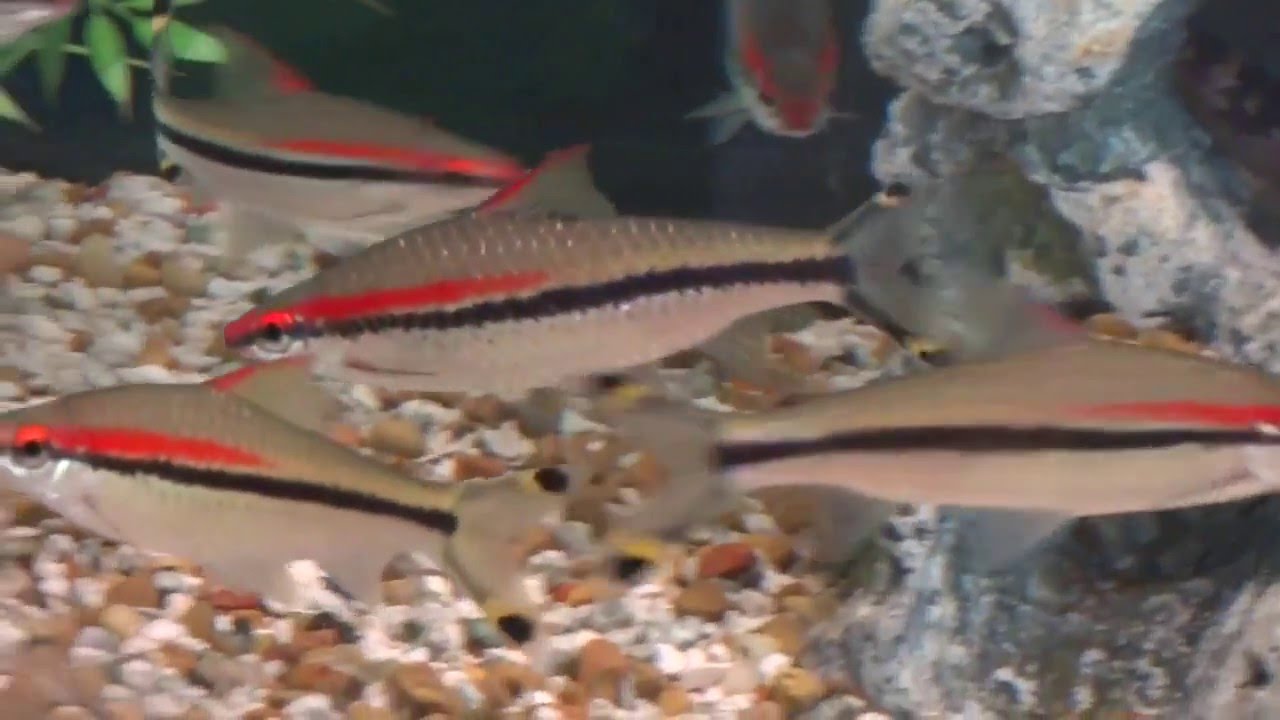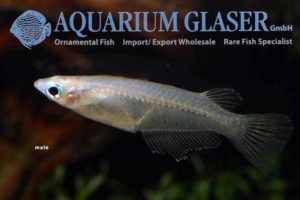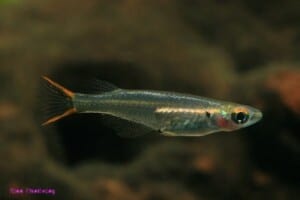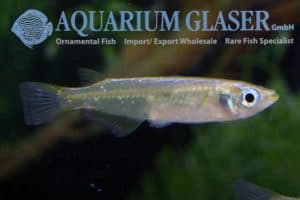Dawkinsia denisonii – Denison Barb
Dawkinsia denisonii was first described in 1865 by Day. The current genus name is Dawkinsia, in honor of Richard Dawkins a famous evolutionary biologist. The species name is a reference to Sir William Denison , he was governor of the province of Madras in India in the 1860s. Their common name is Denison Barb.
Synonyms: Labeo denisonii, Barbus denisonii, Crossocheilus denisonii, Puntius denisonii, Sahyadria denisonii.
Description
Dawkinsia denisonii can reach a length of about 15 centimeters. Sometimes, this fish is called Red Line Torpedo Barb. Their body is shaped like a torpedo, they have silver scales and a red horizontal line runs from the head through the eye to the middle of their body, below that a black horizontal line runs from the head to the tail. They have the colors yellow and black at the end of their tail. The top of the body in adults can become greener, displaying a striking greenish-blue marking on the head.
Distinguishing between male and female Dawkinsia denisonii can be challenging, particularly in younger specimens. Adult females tend to be larger and more robust than males and typically exhibit less vibrant coloration. In contrast, males often display more intense colors. Juveniles usually have a bit more red on the first rays of their dorsal fins. If you observe a school of these fish for a while, you will notice some differences among the adults.
Behavior and Temperament
Dawkinsia denisonii is an active schooling fish that thrives best when kept in groups of at least six in a spacious aquarium. They are peaceful and suitable for community tanks, but it’s important to consider their lively behavior. As fast swimmers, they can become quite active, especially in warmer temperatures.
What is the maximum age a Denison barb can reach?
A Denison Barb can live up to five to eight years with proper care and conditions.
Habitat and Ecology
Geographic Distribution
Dawkinsia denisonii is indigenous to India, particularly in Kerala and Karnataka, where it inhabits various rivers and streams.
Habitat
They are riverine fishes that inhabit clear, oxygen-rich streams and rivers, mainly in the upper reaches of the river basins. They are often found in rocky pools with dense bankside vegetation. The rivers and streams where they inhabit include the Valapatanam, Chaliyar, Kallar, Karyangod, Kuttiyadi, Chandragiri, Sullya, Kuppam, Iritti, Anjarakandipuzha, Bhavani and Bharatapuzha, as well as historical sites in the Chalakudy, Periyar, Pamba and Achankovil rivers. The banks of these water bodies are generally vegetated. The bottom consists of a rocky substrate.
Natural Enemies and Climate
Information about their natural predators in the wild is limited. They live in a tropical climate with a monsoon season (rainy season) from November to January, during which periods of flooding occur.
Diet
In their natural habitat, Dawkinsia denisonii is omnivorous. They feed on a variety of food sources, including worms, insects, crustaceans, plant matter, and other organic debris.
In an aquarium, Dawkinsia denisonii should be provided with a varied diet to ensure their health. This diet can include live foods such as daphnia or artemia, frozen foods like mosquito larvae, vegetables such as spinach or peas, and high-quality dry food suitable for omnivorous fish. A balanced diet is essential for their well-being. It is important to avoid overfeeding, as this can lead to water pollution.
Aquarium Size and Setup
For a group of at least six Dawkinsia denisonii, an aquarium of at least 150 centimeters long is recommended. For larger groups, an even larger aquarium is needed, with the length of the aquarium being the most important aspect. The aquarium should be densely planted along the edges, with sufficient space for swimming in the middle. Use strong plants, as some specimens like to nibble on soft plants and algae. A rocky substrate is suitable, but sand can also be used.
Water parameters
The ideal water parameters for Dawkinsia denisonii are a temperature between 15 and 25 degrees Celsius, a pH between 6.5 and 7.8 and a GH between 5 and 25. Regular water changes are essential to maintain the water quality.
Compatibility with other fish species
The Torpedo Barbel is a peaceful fish that gets along well with other peaceful, not too large species. Suitable tankmates are, for example, small characins. It is important to avoid aggressive or too large fish that could threaten the Dawkinsia denisonii.
Breeding Dawkinsia denisonii
Breeding this species is quite challenging and typically occurs only by chance. In commercial settings, Dawkinsia denisonii is often cultivated using hormones. Various attempts have been made to understand the breeding process, leading to several theories. One theory suggests that gradually increasing the temperature over several days can mimic the natural conditions during the species’ breeding season in the wild. Another theory proposes that lowering the pH may stimulate breeding behavior. However, it remains uncertain how to effectively promote breeding. It’s likely that breeding success increases with the use of a large group of these fish.
In the wild, they lay their eggs during the monsoon (rainy season) from November to January. Usually, they lay eggs twice a year. The 300 to 1,000 eggs are placed between stones on the ground. The eggs hatch after about three to four days.
If you are lucky and your Dawkinsia denisonii reproduce, you can feed the fry with infusoria. When they have grown a bit, you can switch to micro-worms.
Particularities
The Denison Barb is classified as endangered by the IUCN. The population of Dawkinsia denisonii has decreased by 50% in recent years, with some key fishing areas experiencing a decline of up to 70%. This decline is primarily due to overfishing for the aquarium trade. Additionally, pollution and habitat loss have also significantly contributed to their decrease.
Video
Authors
Coby
Rickpad
John de Lange
Copyright images
Hristo Hristov
Andy Gordon
Gerry Verrier
References
IUCNRedlist
Molecular phylogeny and divergence of major clades in the Puntius complex (Teleostei: Cypriniformes)
Biotopeaquariumproject.com
Evaluation of reproductive performance in indigenous endemic ornamental fish Sahyadria denisonii using hormones under captive environment
Assessment of the Potential Impacts of Dawkinsia denisonii (torpedo barb) on the Environment




















